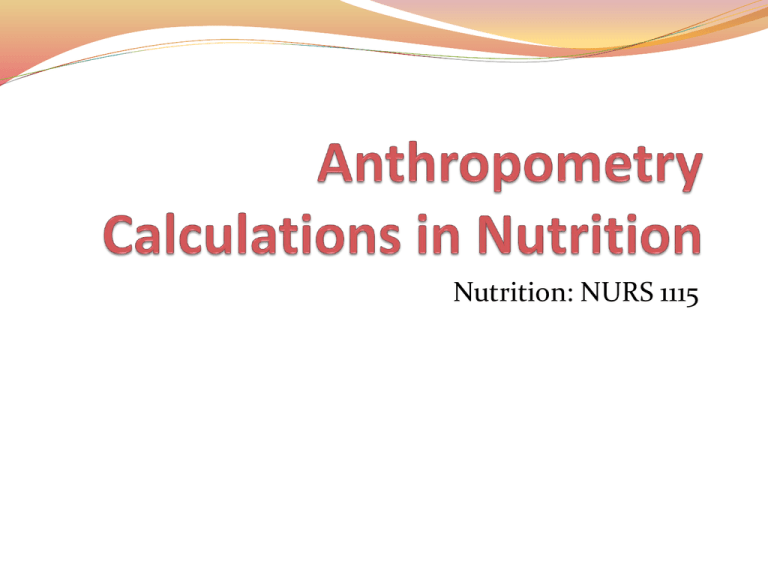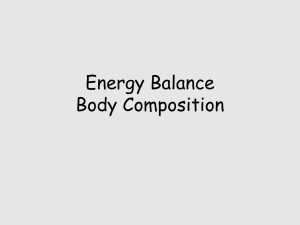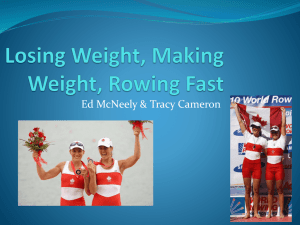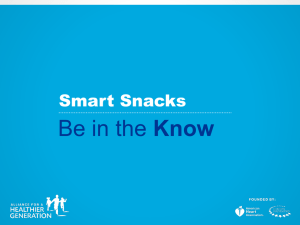File
advertisement

Nutrition: NURS 1115 Conversion Large Unit Small Unit 1 inch 2.54 cm 1kg 2.2 lbs 1 foot 12 inches 1 kcal 4.184 kj 1m 100 cm NB: From a larger unit to a smaller unit multiple. From a smaller unit to a larger unit divide. BMI calculations Weight (kg)/Height(m2) John weighs 5 kg and is .5 m tall. What is his BMI? Answer = 5/ .5 * .5 = 5/ 0.25= 20kg/m2 BMI calculations Weight(lbs)/ Height (inches ) * 703 2 Peter weighs 180 lbs and is six feet tall. Calculate his BMI? Answer =180/ (72 *72)* 703 = 180/5184 * 703 = 0.0347* 703 =24.39 lbs/inches2 http://www.cdc.gov/healthyweight/assessing/bmi/adult _bmi/index.html Caloric Requirements- BMR Harris Benedict Formula Women: BMR = 655 + ( 9.6 x weight in kilos ) + ( 1.8 x height in cm ) - ( 4.7 x age in years ) Men: BMR = 66 + ( 13.7 x weight in kilos ) + ( 5 x height in cm ) - ( 6.8 x age in years ) Calculating BMR for Women: An Example 20 year old Shuana weighs 54kg, and is 1.2 m tall. Calculate her BMR. BMR= 655+ (9.6 * 54) + (1.8 * 120) – (4.7 * 20) 655+ (518.4)+(216)- (94) = 1389.4-94 =1295.4 calories Calculating BMR for Men: An Example 22 year old Shuan weighs 68kg, and is 1.6 m tall. Calculate his BMR. BMR= 66 + (13.7 x 68) + (5 x 160) - (6.8 x 22) = 66+ (931.6)+ (800)-(149.6) =1797.6-149.6 =1648 calcories Calculating Physical Activity Level Total daily energy expenditure (TDEE)/ Basal Metabolic Rate (BMR) Category PAL Description Sedentary 1.2 (little or no exercise, desk job) Lightly active 1.375 (light exercise/sports 1-3 days/wk) Moderately active 1.55 (moderate exercise/sports 3-5 days/wk) Very active 1.725 (hard exercise/sports 6-7 days/wk) Extra Active 1.9 (hard daily exercise/sports & physical job or 2 X day training, marathon, football camp, contest, etc.) Calculating Physical Activity Level If Sharon total energy expenditure for the last 24 hours is 1836.5 kcal and her BMR is 1479.8 kcal what is her PAL? Categorise her PAL. PAL= TDEE/BMR = 1836.5/1479.8 = 1.24 PAL category: Low active Calculating Total Daily Energy Requirement Caloric Requirement- BMR * PAL Shari has a BMR of 1524 kcal/day and is moderately active. How much calories must she take in per day to meet her caloric requirements TER= 1524*1.55 = 2362.22 kcal Atwater factors Macronutrients and Alcohol Energy contribution Protein 4 kcal/g Carbohydrate 4 kcal/g Fat 9 kcal/g Alcohol 7 kcal/g Calculating energy contributionsMacronutrients Each 2gram dumpling consists of 0.5 g of carb and 0.3 g of protein and 0.1 g of fat. Kerry consumes 3 ½ dumplings, 2 grams of salt fish prepared in 2.25 grams of oil. She drinks a bottle of “Sprout juice” which reads 25 grams of carbs and 30 grams of protein, and total fat is 13g per serving. Calculating energy contributionsMacronutrients Each bottle contains 1.5 servings. Calculate the number of calories Kerry receives from fat, carbohydrates, and protein and the total caloric intake for that meal. Energy from carbohydrates Answer Carb= 3.5 * 0.5 from dumpling= 1.75 g From juice= 25 * 1.5= 37.5 g Add all carbs consumed= 1.75 + 37.5= 39.25 g Energy from carb= 39.25g * 4kcal/ 1 g= 157 kcal/g Energy from Fats Fat from dumpling= 3.5 * 0.1= 0.35g Fat from oil= 2.25 g Fat from juice= 13g Add all the fat contribution= 0.35g + 2.25g+ 13g= 15.6g Energy from fat = 15.6g * 9kcal/1 g= 140.4 kcal Energy from Protein Protein from dumpling = 3.5 * 0.3g= 1.05g Protein from juice = 30g* 1.5= 45g Add all the protein contribution= 1.05g + 45 g= 46.05g Energy from Protein= 46.05g * 4Kcal/1 g= 184.2 kcal Total Energy consumed Total energy consumed= sum of fat, protein and carbohydrate energy contribution = 184.2kcal+ 140.4 kcal+ 157kcal = 481.6 kcal Malnutrition Universal Screening Tool (MUST) for adults Step 1. BMI Score 0= > 20 1= 18.5 -20.0 2=< 18.5 Step 2. Unplanned weight loss score 0=<5% 1= 5-10% 2=>10% MUST If wt or ht cannot be established, use documented or recalled values. If none of the values can be obtained: Use clinical impression (very thin, thin, obese) and mid-upper arm circumference (<23.5 cm- thin) & (>32 cm = obese) MUST Wt change: clothes, jewelry loose-fitting =wt loss, or too tight=wt gain History of decreased food intake, loss of appetite or dysphagia over 3-6 months MUST Underlying disease or psychosocial/physical disabilities likely to cause wt change Acute disease with negligible intake MUST Step 3. Acute disease score: 2 = none or negligible intake for >5 days Step 4. Add the scores to calculate overall risk of malnutrition 0 = low risk: routine clinical care 1 = medium risk: observe 2 or more= high risk: treat Calculations of MUST score Jemma is 20 years old and weighed 45kg last month and now weighs 41 kg. He is 155 cm tall. He has had little appetite for the last month and has stage 3 cancer. Calculate his MUST score. Step 1 BMI= 45/1.55 * 1.55= 45/2.4025 18.73kg/m2 Calculations of MUST score Step 2 Percentage weight loss: Current percentage of usual weight- 41/45 *100= 91.11 Percentage weight loss- 100- 91.11= 8.89 % Step 3 Disease score= 2 Step 4 compute the scores BMI score= 1 Weight loss score= 1 Disease score= 2 Total score= 4 Recommendation High Risk-Treat Calculating Waist Hip Ratio Waist (unit)/hip (unit) NB units must be the same WHR is the ratio of the circumference of the waist to that of the hip Recommendations WHO STEPS states that abdominal obesity is defined as a waist–hip ratio above 0.90 for males and above 0.85 for females and increased cardiovascular risk Calculating Waist Hip Ratio Freta has a waist circumference of 32 cm and a hip circumference of 14.96 in What is her WHR and your recommendations for her? WHR = WC/HC in same unit Convert HC- cm= 14.96 in* 2.54cm/ 1 in= 38 cm Divide WC by HC=32/38 = 0.84 Low cardiovascular risk (normal) Caloric intake from IV administration Nurse Joy is caring for critically ill Koju. Koju is ordered to receive 20% DW in 500 mls and 1L requirement. How many calories is Koju receiving daily? How many bags of fluid are needed to meet a requirement of 1600 kcal? Volume of Dextrose in 500ml bag- 20/100 * 500= 100mls 1ml = 1g Thus 100mls dextrose = 100g dextrose Number of calories provided by each bag of DW= volume of dextrose per * 4kcal = 100 * 4kcal= 400kcal Number of calories in 1L= conversion of L= mls 1L = 1000mls Caloric intake from IV administration Number of 500ml bag in 1L= 1000/500= 2 Multiply number of bags by kcals per bag= 2* 400kcal= 800 kcals Answer to number of calories that Koju is receiving daily= 800 kcals Ques 2.- Bags of fluid needed to meet 1600 kcal requirement Divide TEE by calories per bag= 1600kcal/ 400kcal *1 bag= 4 bags Convert bags to mls= 1 bag = 500mls Thus 4 bags = 500 mls* 4bags/ 1 ml= 2000mls Convert to L= 2000ml/ 1000ml * 1L= 2L Caloric Intake_ Macronutrients Square has a TEE of 1850 kcal per day? What is the expected contribution of the three macronutrients; using the ratio of carbs – 55%, protein- 30%, fats- 15%. Carb= 1850* 55/100= 1017.5 kcal Protein= 1850 * 30/100= 555 kcal Fats= 1850 * 15/100= 277.5 kcal Total= ( 1017.5 + 555 + 277.5) kcal= 1850 Kcal Caloric Intake_ Macronutrients Paige has a TEE of 1920 Kcal/d? What mass of macronutrients should she consume to meet RDA; using RDA values of 55% carb, 30% protein & 15% fats. Mass of Carbs required for 1 day Carb= 1920 kcal * 55/100= 1056 kcal Kcal to gram= 1056/ 4 kcal * 1 g= 264 g Mass of Protein required for 1 day Protein= 1920* 30/100= 576 kcal Kcal to gram= 576/ 4kcal * 1g= 144 g Mass of Fats required for 1 day Fat= 1920 * 15/100= 288 kcal Kcal to gram= 288/9 kcal * 1g= 32 g Calculating Ideal weight Usual Frame size can be estimated using wrist circumference, or elbow breadth measurement. Growth charts and assessment of children James is 6 months old and weighs 6.5 kg and is 22 cm tall. Using the growth chart for boys identify his percentile: Weight for age Weight for length Length for age BMI for age – weight for length for age Growth Charts\L_A and W_A growth charts (Boys).pdf Growth Charts\W_L growth charts.pdf References Retrieved from http://www.cdc.gov/healthyweight/assessing/bmi/adu lt_bmi/index.html Xuereb, G. C. (2004). Healthy eating for better living: A manual on nutrition and HIV/AIDS for healthcare workers in the Caribbean. Cajanus, 37(4): 171-224. Retrieved from www.paho.org/cfni Retrieved from http://www.who.int/childgrowth/en





